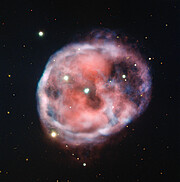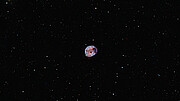Comunicato Stampa
Stelle e teschi: la nuova immagine dell'ESO rivela una nebulosa spettrale
30 Ottobre 2020
Questo residuo etereo di una stella morta da tempo, annidato nel ventre della Balena, ha una raccapricciante somiglianza con un teschio che fluttua nello spazio. Catturata con dettagli sorprendenti dal VLT (Very Large Telescope) dell'ESO, l'inquietante Nebulosa Teschio è mostrata in questa nuova immagine con bellissimi colori iniettati di sangue. Questa nebulosa planetaria è associata a una coppia compatta di stelle intorno a cui orbita una terza stella. È la prima nebulosa planetaria di questo tipo che sia stata scoperta.
Nota anche come NGC 246, la Nebulosa Teschio si trova a circa 1600 anni luce dalla Terra nella costellazione meridionale della Balena. Si è formata quando una stella simile al Sole ha espulso i propri strati esterni durante gli anni della vecchiaia, lasciando solo il nucleo nudo - una nana bianca - una delle due stelle che si vedono proprio al centro di NGC 246.
Anche se questa nebulosa è nota da secoli, solo nel 2014 gli astronomi hanno scoperto, utilizzando il VLT dell'ESO, che la nana bianca e la sua compagna nascondono una terza stella situata nel cuore della Nebulosa Teschio. Questa stella, non visibile in questa immagine, è una debole nana rossa che si trova vicina alla nana bianca, a circa 500 volte la distanza tra la Terra e il Sole. Le nana rossa e la nana bianca orbitano l'una intorno all'altra formando una coppia, mentre la stella esterna orbita intorno alle due nane a una distanza di circa 1900 volte la distanza Terra-Sole. Tutte insieme, queste tre stelle danno a NGC 246 un primato. È la prima nebulosa planetaria conosciuta con un sistema stellare triplo (gerarchico) al centro.
Scattata dallo strumento FORS 2 installato sul VLT dell'ESO nel deserto cileno di Atacama, questa nuova immagine della Nebulosa Teschio cattura intenzionalmente la luce emessa in alcune ristrette bande di lunghezza d'onda, quelle associate all'idrogeno e all'ossigeno gassoso. Le osservazioni della luce emessa da elementi particolari aiutano a rivelare una grande quantità di informazioni sulla composizione chimica e strutturale di un oggetto. La nuova immagine della Nebulosa Teschio evidenzia dove NGC 246 è ricco o povero di idrogeno (mostrato in rosso) e ossigeno (raffigurato in azzurro).
Questa immagine è stata selezionata come parte del programma Gemme Cosmiche dell'ESO, un'iniziativa di divulgazione pensata per produrre immagini di oggetti interessanti o anche solo piacevoli da vedere utilizzando i telescopi dell'ESO, ai fini didattici e di divulgazione al pubblico. Il programma utilizza il tempo del telescopio che non è adatto per le osservazioni scientifiche. Tutti i dati raccolti potrebbero in ogni caso essere interessanti anche per scopi scientifici e sono perciò messi a disposizione degli astronomi attraverso l'archivio scientifico dell'ESO.
Ulteriori Informazioni
L'ESO (European Southern Observatory, o Osservatorio Australe Europeo) è la principale organizzazione intergovernativa di Astronomia in Europa e di gran lunga l'osservatorio astronomico più produttivo al mondo. È sostenuto da 16 paesi: Austria, Belgio, Danimarca, Finlandia, Francia, Germania, Irlanda, Italia, Paesi Bassi, Polonia, Portogallo, Regno Unito, Repubblica Ceca, Spagna, Svezia, e Svizzera, oltre al paese che ospita l'ESO, il Cile e l'Australia come partner strategico. L'ESO svolge un ambizioso programma che si concentra sulla progettazione, costruzione e gestione di potenti strumenti astronomici da terra che consentano agli astronomi di realizzare importanti scoperte scientifiche. L'ESO ha anche un ruolo di punta nel promuovere e organizzare la cooperazione nella ricerca astronomica. L'ESO gestisce tre siti osservativi unici al mondo in Cile: La Silla, Paranal e Chajnantor. Sul Paranal, l'ESO gestisce il Very Large Telescope, osservatorio astronomico d'avanguardia nella banda visibile e due telescopi per survey. VISTA, il più grande telescopio per survey al mondo, lavora nella banda infrarossa mentre il VST (VLT Survey Telescope) è il più grande telescopio progettato appositamente per produrre survey del cielo in luce visibile. L'ESO è il partner principale di APEX e di ALMA, il più grande progetto astronomico esistente, sulla piana di Chajnantor. E sul Cerro Armazones, vicino al Paranal, l'ESO sta costruendo l'Extremely Large Telescope o ELT (significa Telescopio Estremamente Grande), un telescopio da 39 metri che diventerà "il più grande occhio del mondo rivolto al cielo".
La traduzione dall'inglese dei comunicati stampa dell'ESO è un servizio dalla Rete di Divulgazione Scientifica dell'ESO (ESON: ESO Science Outreach Network) composta da ricercatori e divulgatori scientifici da tutti gli Stati Membri dell'ESO e altri paesi. Il nodo italiano della rete ESON è gestito da Anna Wolter.
Links
- Il programma Gemme Cosmiche dell'ESO
- Fotografie del VLT
- Per i ricercatori: avete una storia da raccontare? Inviateci il vostro articolo scientifico
Contatti
Bárbara Ferreira
ESO Public Information Officer
Garching bei München, Germany
Tel.: +49 89 3200 6670
Cell.: +49 151 241 664 00
E-mail: pio@eso.org
Anna Wolter (press contact Italia)
Rete di divulgazione scientifica dell'ESO
e INAF-Osservatorio Astronomico di Brera
Milano, Italy
Tel.: +39 02 72320321
E-mail: eson-italy@eso.org
Sul Comunicato Stampa
| Comunicato Stampa N": | eso2019it |
| Nome: | NGC246 |
| Tipo: | Milky Way : Star : Evolutionary Stage : White Dwarf Milky Way : Nebula : Type : Planetary |
| Facility: | Very Large Telescope |
| Instruments: | FORS2 |
Our use of Cookies
We use cookies that are essential for accessing our websites and using our services. We also use cookies to analyse, measure and improve our websites’ performance, to enable content sharing via social media and to display media content hosted on third-party platforms.
ESO Cookies Policy
The European Organisation for Astronomical Research in the Southern Hemisphere (ESO) is the pre-eminent intergovernmental science and technology organisation in astronomy. It carries out an ambitious programme focused on the design, construction and operation of powerful ground-based observing facilities for astronomy.
This Cookies Policy is intended to provide clarity by outlining the cookies used on the ESO public websites, their functions, the options you have for controlling them, and the ways you can contact us for additional details.
What are cookies?
Cookies are small pieces of data stored on your device by websites you visit. They serve various purposes, such as remembering login credentials and preferences and enhance your browsing experience.
Categories of cookies we use
Essential cookies (always active): These cookies are strictly necessary for the proper functioning of our website. Without these cookies, the website cannot operate correctly, and certain services, such as logging in or accessing secure areas, may not be available; because they are essential for the website’s operation, they cannot be disabled.
Functional Cookies: These cookies enhance your browsing experience by enabling additional features and personalization, such as remembering your preferences and settings. While not strictly necessary for the website to function, they improve usability and convenience; these cookies are only placed if you provide your consent.
Analytics cookies: These cookies collect information about how visitors interact with our website, such as which pages are visited most often and how users navigate the site. This data helps us improve website performance, optimize content, and enhance the user experience; these cookies are only placed if you provide your consent. We use the following analytics cookies.
Matomo Cookies:
This website uses Matomo (formerly Piwik), an open source software which enables the statistical analysis of website visits. Matomo uses cookies (text files) which are saved on your computer and which allow us to analyze how you use our website. The website user information generated by the cookies will only be saved on the servers of our IT Department. We use this information to analyze www.eso.org visits and to prepare reports on website activities. These data will not be disclosed to third parties.
On behalf of ESO, Matomo will use this information for the purpose of evaluating your use of the website, compiling reports on website activity and providing other services relating to website activity and internet usage.
Matomo cookies settings:
Additional Third-party cookies on ESO websites: some of our pages display content from external providers, e.g. YouTube.
Such third-party services are outside of ESO control and may, at any time, change their terms of service, use of cookies, etc.
YouTube: Some videos on the ESO website are embedded from ESO’s official YouTube channel. We have enabled YouTube’s privacy-enhanced mode, meaning that no cookies are set unless the user actively clicks on the video to play it. Additionally, in this mode, YouTube does not store any personally identifiable cookie data for embedded video playbacks. For more details, please refer to YouTube’s embedding videos information page.
Cookies can also be classified based on the following elements.
Regarding the domain, there are:
- First-party cookies, set by the website you are currently visiting. They are stored by the same domain that you are browsing and are used to enhance your experience on that site;
- Third-party cookies, set by a domain other than the one you are currently visiting.
As for their duration, cookies can be:
- Browser-session cookies, which are deleted when the user closes the browser;
- Stored cookies, which stay on the user's device for a predetermined period of time.
How to manage cookies
Cookie settings: You can modify your cookie choices for the ESO webpages at any time by clicking on the link Cookie settings at the bottom of any page.
In your browser: If you wish to delete cookies or instruct your browser to delete or block cookies by default, please visit the help pages of your browser:
Please be aware that if you delete or decline cookies, certain functionalities of our website may be not be available and your browsing experience may be affected.
You can set most browsers to prevent any cookies being placed on your device, but you may then have to manually adjust some preferences every time you visit a site/page. And some services and functionalities may not work properly at all (e.g. profile logging-in, shop check out).
Updates to the ESO Cookies Policy
The ESO Cookies Policy may be subject to future updates, which will be made available on this page.
Additional information
For any queries related to cookies, please contact: pdprATesoDOTorg.
As ESO public webpages are managed by our Department of Communication, your questions will be dealt with the support of the said Department.





